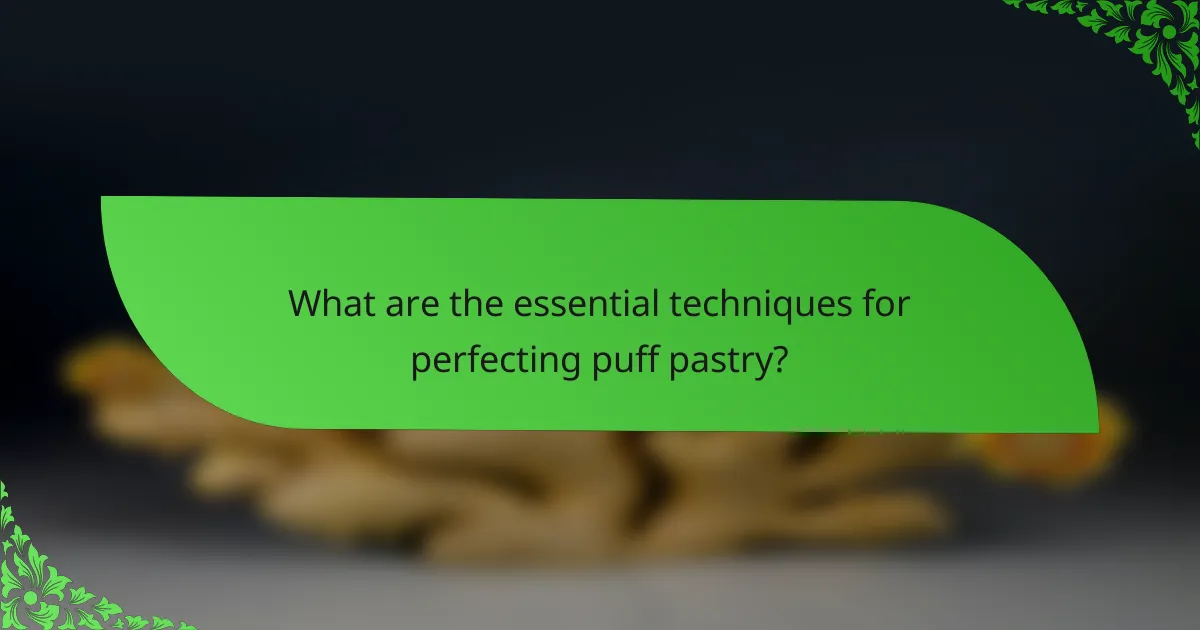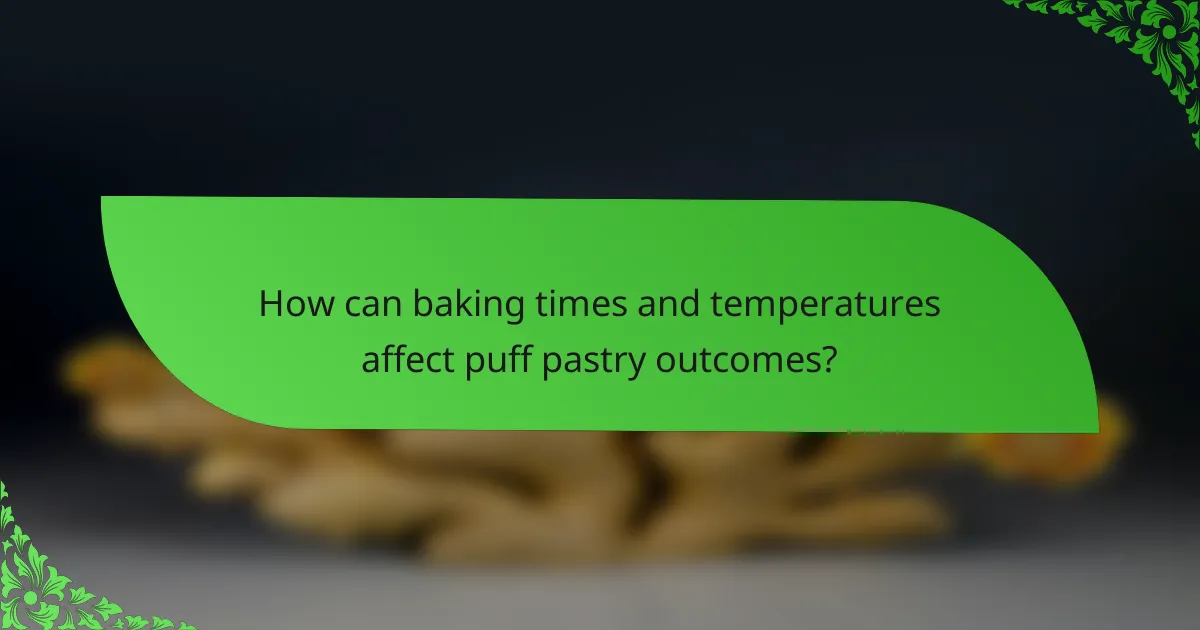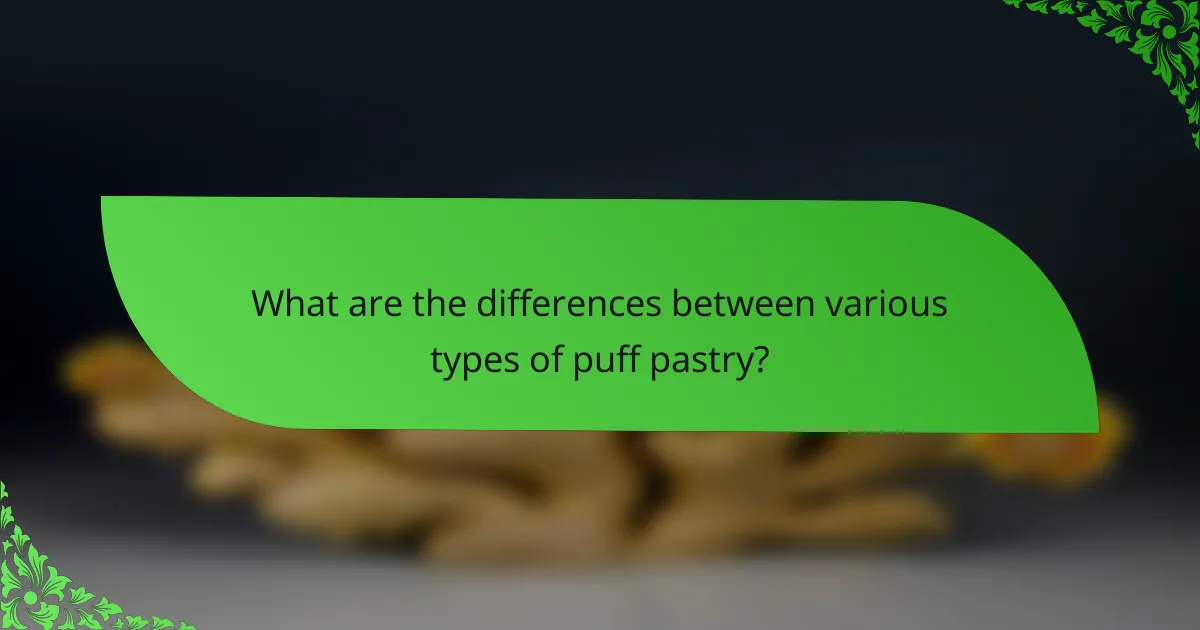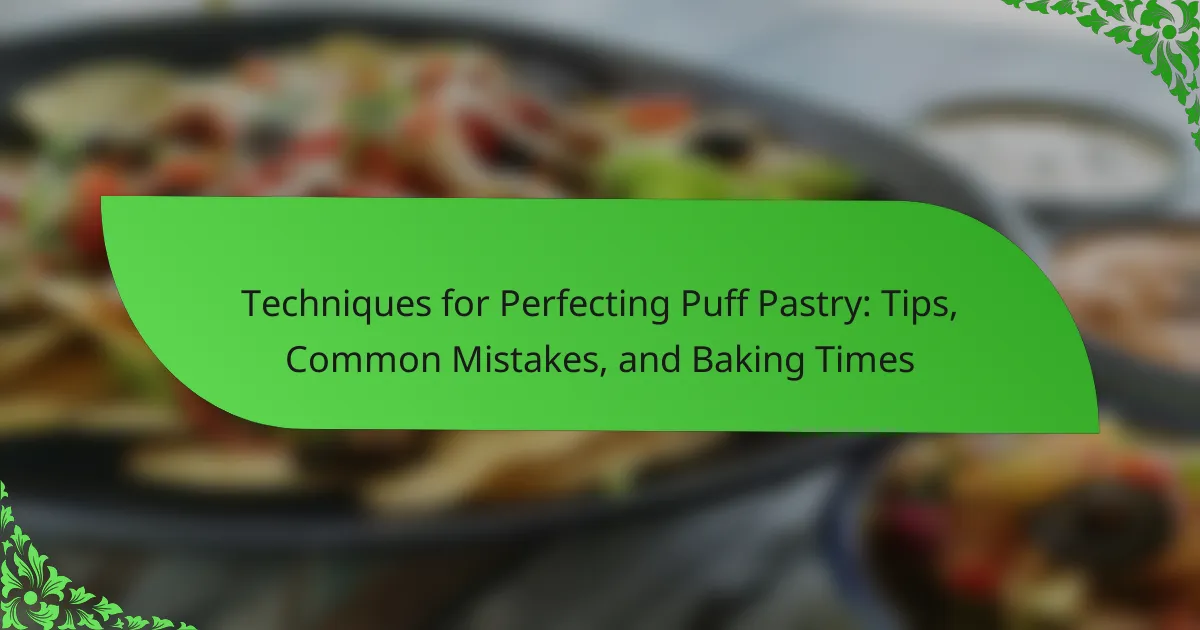Puff pastry is a versatile dough known for its light and flaky texture, achieved through specific techniques such as dough preparation, temperature control, and lamination. Key methods include using cold ingredients, rolling the dough evenly, and performing multiple folds to create distinct layers. Proper baking times and temperatures, typically between 400°F to 425°F for 20 to 30 minutes, are crucial for optimal puffing and flavor development through the Maillard reaction. The article also distinguishes between different types of puff pastry, including traditional, rough puff, and Danish pastry, each serving unique culinary purposes. Common mistakes in puff pastry preparation and baking are highlighted to ensure successful results.

What are the essential techniques for perfecting puff pastry?
The essential techniques for perfecting puff pastry include proper dough preparation, temperature control, and lamination. Start by using cold ingredients to maintain the dough’s temperature. This helps create distinct layers. Next, roll the dough evenly to achieve uniform thickness. Use a light touch to avoid compressing the layers. Lamination involves folding and rolling the dough multiple times to create layers. Aim for at least six folds for optimal puffing. Additionally, chilling the dough between folds is crucial to keep the butter firm. Finally, ensure even baking by preheating the oven and using a baking stone if possible. These techniques are backed by culinary standards that emphasize the importance of temperature and technique in pastry making.
How does the layering process influence puff pastry quality?
The layering process is crucial for puff pastry quality. It creates distinct layers of dough and butter, which expand during baking. This expansion results in a flaky and airy texture. Each layer traps steam, contributing to the rise. A well-executed layering process leads to a more pronounced puff. Proper temperature management during layering ensures the butter remains solid. If the butter melts too much, the layers can merge, resulting in a dense pastry. Consistent rolling and folding techniques enhance the overall pastry structure. Studies show that a minimum of six folds can significantly improve flakiness.
What specific methods can enhance the lamination of dough?
Cold ingredients enhance the lamination of dough. Using cold butter and chilled water maintains the dough’s temperature. This prevents the butter from melting into the dough. Proper temperature control creates distinct layers.
Frequent folds increase the number of layers. Each fold creates more surface area for steam to expand. This results in a flakier texture. Aim for at least six folds for optimal results.
Resting the dough is crucial. Allowing the dough to rest prevents gluten from overdeveloping. This makes the dough easier to roll out. It also helps maintain the integrity of the layers.
Using the right flour matters. High-protein flour provides better structure. This supports the layers during baking.
Finally, proper rolling technique is essential. Roll from the center outwards to maintain even thickness. Uneven thickness can lead to inconsistent baking.
Why is temperature control crucial during the preparation of puff pastry?
Temperature control is crucial during the preparation of puff pastry because it affects the dough’s lamination and flakiness. Puff pastry relies on layers of dough and butter to create its signature texture. If the dough becomes too warm, the butter will melt into the dough. This melting prevents the formation of distinct layers, resulting in a dense pastry. Conversely, if the dough is too cold, it can become difficult to roll out and may crack. The ideal temperature for both the dough and the butter is around 50°F (10°C). This temperature allows the butter to remain solid while being pliable enough to be rolled into the dough. Maintaining proper temperature ensures that the layers expand during baking, creating the desired puff and crispness.
What common mistakes should be avoided when making puff pastry?
Common mistakes to avoid when making puff pastry include using warm ingredients. Warm butter can melt and prevent proper layering. Another mistake is not resting the dough adequately. Resting allows gluten to relax, ensuring better flakiness. Overworking the dough is also a frequent error. This can lead to tough pastry instead of light and airy layers. Additionally, failing to roll out the dough evenly can create uneven layers. Uneven layers affect the rise during baking. Not chilling the dough between folds is another mistake. Chilling is crucial for maintaining the butter’s solid state. Lastly, neglecting to preheat the oven can result in poor puffing. A properly preheated oven is essential for achieving the desired texture.
How can improper dough handling affect the final product?
Improper dough handling can lead to a poor final product in puff pastry. It can result in uneven layers and inadequate rise. Overworking the dough can develop gluten excessively, making it tough. Insufficient chilling can cause butter to melt into the dough, preventing proper flakiness. Mishandling can also lead to inconsistent thickness, resulting in uneven baking. These factors directly impact texture and flavor. Research indicates that proper lamination techniques are essential for achieving desired pastry quality.
What are the signs of overworking the dough, and how can it be prevented?
Signs of overworking the dough include a tough texture and excessive elasticity. The dough may also become overly sticky and difficult to handle. Overworked dough results in poor rise and flaky layers during baking. To prevent overworking, mix ingredients until just combined. Use gentle folding techniques instead of vigorous kneading. Limit the time spent handling the dough. Chilling the dough between stages can also help maintain its integrity. Properly monitor the dough’s texture and stop once it is smooth and cohesive.
What tips can help achieve the best results with puff pastry?
To achieve the best results with puff pastry, keep the dough cold throughout the process. Cold butter creates distinct layers, leading to better puffing. Use a light hand when rolling out the dough to maintain its structure. Avoid overworking the pastry, as this can develop gluten and hinder flakiness. Chill the pastry after shaping to ensure it retains its form during baking. Preheat the oven to a high temperature for optimal rise. Use parchment paper to prevent sticking and ensure even baking. Lastly, brush the surface with egg wash for a golden finish. These tips are essential for perfect puff pastry results.
How can the choice of ingredients impact the texture and flavor?
The choice of ingredients significantly impacts the texture and flavor of puff pastry. Different types of flour can alter the gluten structure, affecting the pastry’s flakiness. For instance, all-purpose flour yields a tender texture, while bread flour provides more chewiness. The fat used, such as butter or margarine, influences both flavor and moisture. Butter adds richness and a distinct taste, while margarine may result in a less flavorful pastry. The ratio of fat to flour is crucial; more fat creates a flakier texture. Additionally, the type of liquid, like water or milk, can enhance flavor and tenderness. Cold ingredients help maintain the pastry’s structure during baking. Overall, ingredient choices directly determine the final quality of puff pastry.
What tools and equipment are recommended for making puff pastry?
To make puff pastry, essential tools and equipment include a clean work surface, rolling pin, and pastry cutter. A clean work surface allows for easy handling of the dough. A rolling pin is necessary for evenly rolling out the dough. A pastry cutter helps in cutting the dough into desired shapes. Additionally, a baking sheet is required for placing the pastry before baking. Parchment paper can be used to prevent sticking on the baking sheet. A pastry brush is useful for applying egg wash or glaze. Lastly, a refrigerator is important for chilling the dough between folds to achieve the desired flakiness.

How can baking times and temperatures affect puff pastry outcomes?
Baking times and temperatures significantly influence puff pastry outcomes. Proper baking ensures the pastry rises correctly and achieves a flaky texture. High temperatures, typically around 400°F to 425°F, encourage steam formation, which is crucial for puffing. Insufficient heat may lead to dense, undercooked pastry.
Baking for too long can result in over-browning or burning, affecting flavor and texture. Ideal baking times usually range from 20 to 30 minutes, depending on the recipe and oven characteristics. Monitoring the pastry’s color and texture during baking is essential for optimal results.
Research indicates that the Maillard reaction, which occurs at higher temperatures, enhances flavor development in baked goods, including puff pastry. Therefore, maintaining the right temperature and time is critical for achieving the desired outcome in puff pastry.
What is the ideal baking temperature for puff pastry?
The ideal baking temperature for puff pastry is 400°F (200°C). This temperature allows the layers to rise properly while achieving a golden, flaky texture. Baking at this temperature ensures that the water in the dough turns to steam quickly. This steam is essential for creating the lift that puff pastry is known for. Many professional bakers recommend preheating the oven to this temperature for optimal results. Consistent results can be achieved by monitoring the pastry as it bakes. Puff pastry typically takes about 20 to 25 minutes to bake fully at this temperature.
How does the thickness of the pastry influence baking time?
The thickness of the pastry directly influences baking time. Thicker pastry requires a longer baking time to ensure even cooking throughout. This is due to the increased mass that needs to be heated. Conversely, thinner pastry bakes more quickly. It allows heat to penetrate more easily, resulting in shorter baking times. For example, a pastry that is 1/4 inch thick may bake in 15 minutes, while a 1/2 inch thick pastry could take 25 minutes or more. Adjusting baking time according to thickness ensures optimal texture and doneness. This principle is crucial for achieving the desired flakiness and color in puff pastry.
Why is it important to preheat the oven before baking puff pastry?
Preheating the oven before baking puff pastry is crucial for achieving optimal results. Puff pastry relies on steam to create its signature layers. If the oven is not preheated, the pastry will not rise properly. This can result in a dense texture rather than the desired flakiness. The ideal baking temperature for puff pastry is typically around 400°F (200°C). At this temperature, the fat in the pastry melts quickly, generating steam. This steam causes the layers to separate and rise. Therefore, preheating ensures that the pastry cooks evenly and achieves the right texture.
What are the best practices for monitoring puff pastry while baking?
The best practices for monitoring puff pastry while baking include checking for even browning and proper puffing. Observing the pastry through the oven window prevents heat loss. Rotate the baking sheet halfway through the baking time for uniform cooking. Use a thermometer to ensure the internal temperature reaches 200°F for doneness. Additionally, avoid opening the oven door frequently, as this can disrupt the baking process. These practices help achieve a flaky and well-risen pastry. Proper monitoring ensures that puff pastry develops its characteristic texture and flavor.
How can visual cues indicate when puff pastry is ready?
Puff pastry is ready when it is golden brown and has visibly puffed up. The surface should appear crisp and flaky. A well-baked puff pastry will have multiple layers that are distinct. The edges may appear slightly darker than the center, indicating proper cooking. Additionally, if you gently press the surface, it should feel firm and not doughy. These visual indicators confirm that the pastry has cooked through. Baking typically takes around 20 to 30 minutes at a temperature of 375°F to 400°F. Observing these cues ensures the pastry achieves the desired texture and flavor.
What role does steam play in the baking process of puff pastry?
Steam is crucial in the baking process of puff pastry as it creates the desired layers and flakiness. During baking, the moisture in the dough turns to steam. This steam expands rapidly, causing the layers of pastry to separate. The high temperatures in the oven help to generate this steam effectively. As the steam pushes against the layers, it creates a light and airy texture. The result is a puff pastry that is both flaky and tender. This steam-induced expansion is a key characteristic of successful puff pastry.

What are the differences between various types of puff pastry?
Puff pastry types differ primarily in their preparation methods and resulting textures. Traditional puff pastry involves multiple layers of dough and butter, creating a light, flaky texture. Rough puff pastry simplifies the process by incorporating butter into the dough more quickly, resulting in a slightly denser texture.
Choux pastry, while not a puff pastry, uses steam for leavening, creating a hollow structure ideal for eclairs and cream puffs. Danish pastry is a sweet variation that includes yeast, which adds a richer flavor and a softer crumb.
Each type serves distinct culinary purposes, with traditional puff pastry being favored for savory and sweet dishes requiring a delicate, flaky finish. Rough puff is often chosen for quicker recipes. Danish pastry offers a sweet, enriched alternative for breakfast and desserts.
How does rough puff pastry differ from traditional puff pastry?
Rough puff pastry differs from traditional puff pastry primarily in its method of preparation. Traditional puff pastry involves a labor-intensive process of folding and rolling layers of dough and butter multiple times. This technique creates a high number of layers, resulting in a lighter and flakier texture. In contrast, rough puff pastry simplifies the process by combining flour, butter, and water in a less meticulous manner.
The butter is typically cut into the flour rather than being layered, which reduces the number of folds required. This results in fewer layers but still produces a flaky texture. Rough puff pastry is quicker to make and often used for recipes where time is a factor. The final product is generally denser than traditional puff pastry but still maintains a desirable flakiness.
What unique attributes does blitz pastry offer?
Blitz pastry offers a quick preparation method for making puff pastry. It combines the simplicity of mixing flour and fat with the technique of folding and rolling. This method reduces the time required to achieve a flaky texture. Blitz pastry typically requires fewer layers than traditional puff pastry. It can be made in about 30 minutes, making it a time-efficient option. The dough can still achieve a desirable rise when baked. This method is particularly useful for home bakers seeking convenience. Blitz pastry maintains a balance between ease of preparation and quality results.
In what scenarios would one type of puff pastry be preferred over another?
Different types of puff pastry are preferred for various culinary applications. For instance, a classic puff pastry is ideal for making flaky pastries like croissants and mille-feuille. This type has many layers that create a light and airy texture when baked. Conversely, a rough puff pastry is suitable for recipes requiring a quicker preparation time, such as savory tarts. Its simpler method results in a slightly denser texture but still offers flakiness.
Additionally, a quick puff pastry may be chosen for applications needing a fast turnaround, like appetizers. It requires less chilling time and is easier to handle. Specific dishes, such as pot pies, benefit from a thicker puff pastry that holds moisture well. Each type of puff pastry serves unique purposes based on texture, preparation time, and desired outcome in the final dish.
What practical tips can improve your puff pastry baking experience?
To improve your puff pastry baking experience, ensure your ingredients are cold. Cold butter and water create distinct layers. Roll the dough evenly to maintain consistent thickness. This prevents uneven baking. Use a sharp knife to cut the pastry, avoiding squashing the layers. Chill the dough between folds for better rise. Avoid overworking the dough to maintain flakiness. Preheat your oven adequately for optimal puffing. Lastly, use parchment paper to prevent sticking and ensure even heat distribution.
How can you troubleshoot common puff pastry issues during baking?
To troubleshoot common puff pastry issues during baking, identify specific problems like sogginess, lack of rise, or uneven baking. Sogginess can occur if the pastry is not baked long enough or if the filling is too wet. Ensure the pastry is fully cooked by checking for a golden-brown color. Lack of rise may result from insufficient chilling of the dough or improper layering. Keep the dough cold between folds to maintain flaky layers. Uneven baking can happen if the oven temperature is incorrect. Use an oven thermometer to verify the temperature. Additionally, rotate the baking sheet halfway through baking for even heat distribution.
What are some creative uses for leftover puff pastry scraps?
Leftover puff pastry scraps can be creatively repurposed in various ways. One option is to make pastry twists. Simply cut the scraps into strips, twist them, and bake until golden. Another idea is to create mini tarts. Press the scraps into muffin tins, fill with sweet or savory ingredients, and bake. You can also make palmiers by rolling the scraps with sugar and folding them before baking. Additionally, use the scraps to top soups or casseroles for a flaky crust. Finally, consider making decorative pie tops by cutting shapes from the scraps and layering them on a pie filling. These methods maximize the use of puff pastry and reduce waste.
The main entity of this article is puff pastry, focusing on essential techniques for perfecting its preparation and baking. Key topics include proper dough preparation, temperature control, and the lamination process, which are crucial for achieving distinct layers and optimal flakiness. The article also addresses common mistakes to avoid, such as using warm ingredients and inadequate resting of the dough, and provides practical tips for monitoring baking times and temperatures. Additionally, it explores various types of puff pastry and their unique attributes, offering insights for both novice and experienced bakers.
